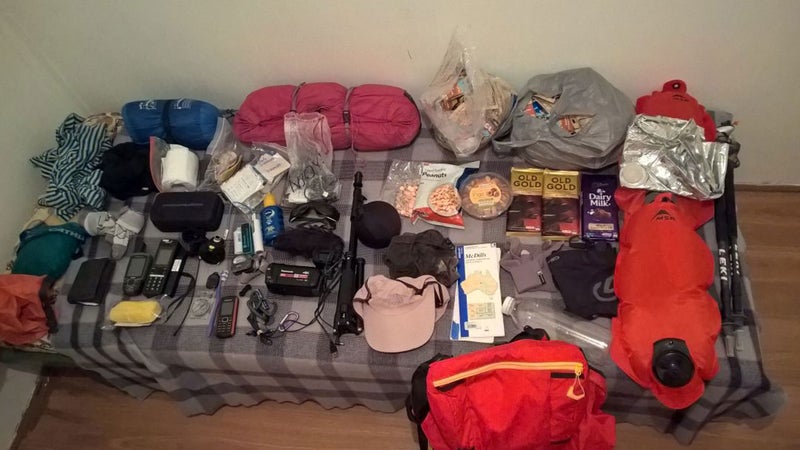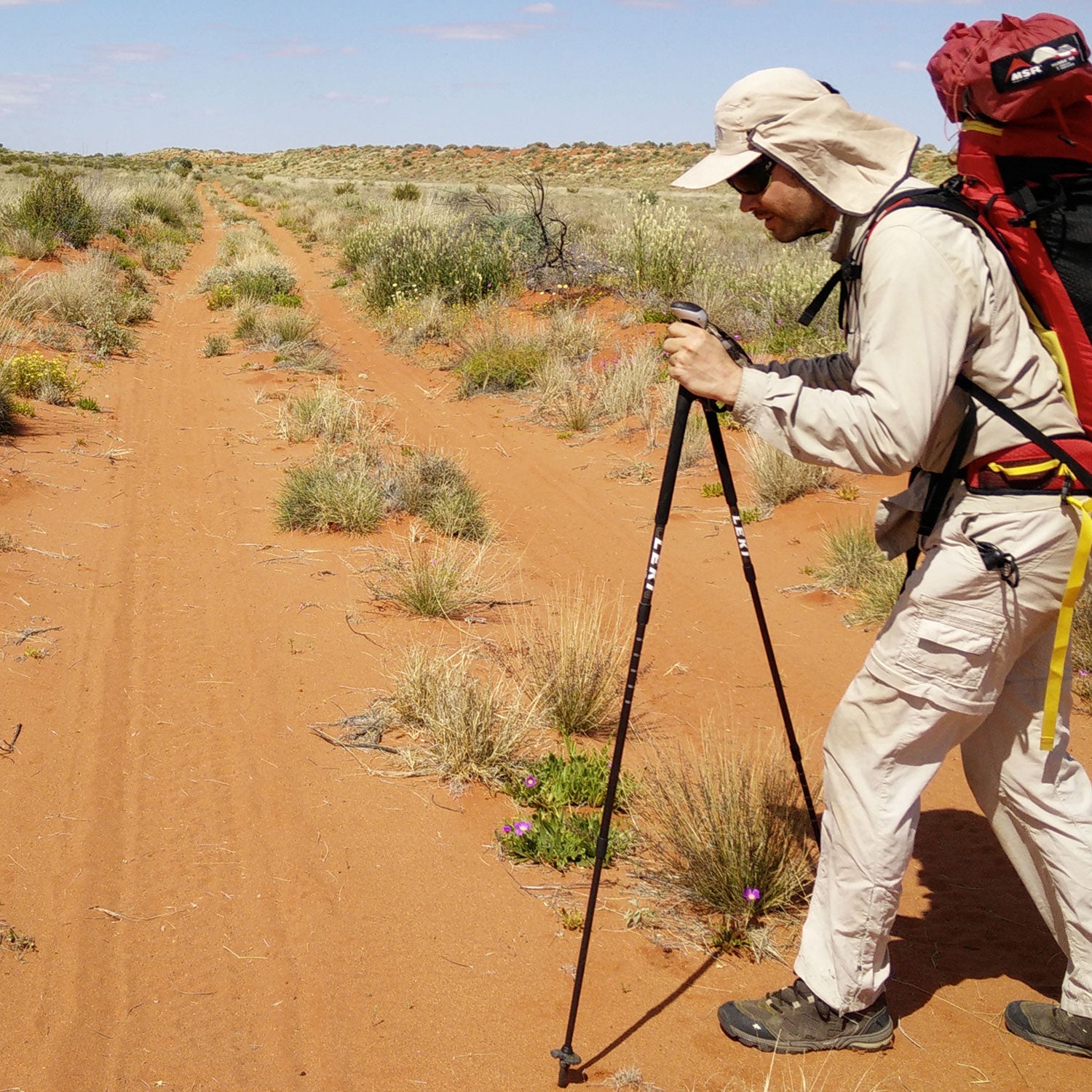Louis-Philippe Loncke is a man attracted to extremes. “I think I am the worldwide specialist in hardcore desert trekking,” the 39-year-old Belgian adventurer says.
Last year, Loncke, an IT consultant with a mop of brown hair and a boyish grin who had never donned a pair of hiking boots until his mid-twenties, became , covering 143 miles in eight days with only the food and water on his back. He’s also hiked the length of Iceland. Next month, he’s going to the world’s largest salt flats—a 4,247-square-mile swath in Bolivia called Salar de Uyuni, and its neighbor, Salar de Coipasa. Backpacking through the world’s harshest environs is quickly becoming his stock in trade. Loncke says he loves the solitude and sense of accomplishment of long-distance treks, and began seeking out firsts a decade ago.
In August, Loncke returned to the site of one of his first treks, the Simpson Desert in central Australia. It’s a harsh, arid expanse of sand dunes—the largest in the world—six times the size of his native Belgium. In 2008, when Loncke first visited the Simpson, he used a cart to haul his supplies. , he brought along only the goods he could fit in his backpack. He covered nearly 200 of his intended 283 miles before deciding the two liters and half-pound of food left in his bag wouldn’t be enough to carry him through. On August 26, he phoned in the local ranger for an evac. While he didn’t finish, Loncke believes his attempt proves that such a crossing—sans sled—is possible.
We caught up with Loncke a few days ago to talk about carrying a 130-plus-pound pack through sand and whether there’s room for a girlfriend in the life of an explorer.
OUTSIDE: You did this trip unsupported—with no caches or anything—and your pack weighed 132 pounds. That’s insane.
LONCKE: It’s absolutely horrible how much my pack weighed.
Carrying that thing around barely seems possible to me.
I found an article on the energy consumption of African ladies who carry big jars of water on their heads. The jar goes up to 20 to 30 kilograms of water—60 or 70 pounds—and it’s just on their head. Women do that every single day. They take many small steps—like a machine—just small, small steps. And their consumption of energy is very low.
When I started, I was like, if the African ladies can do it, I can. It is possible, but it’s super hard and fucking painful. This pack is a mountaineering pack. I strap it to my hips so strong to carry the most possible weight on my legs. Of course, that compresses so much of my stomach. If I drink too much, I start to have nausea and vomiting because of the straps pressing into my stomach. The shoulder straps are really only just to keep the pack from falling backwards.
Almost 90 pounds of your pack went to hauling 10.5 gallons of water. What else did you carry?
Sleeping bag, tent, walking sticks, mattress pad, camera gear, tripods, memory stick, headlight, meal bars—no stove. And then water bladders and half a roll of toilet paper—my only luxury.
“If I drink too much, I start to have nausea and vomiting because of the straps pressing into my stomach.”
Why did you do this to yourself?
I had nothing to prove in the Simpson. I’d already done the longest trek there ever, in time and distance. The idea was to see how far can you go with just a backpack. With a cart, it has been done twice. But with only a backpack, we did not know. I made it walking distance of around 300 kilometers [185 miles] and reached the Poeppel Corner, the corner of three Australian states. My gold medal would have been to make it to the city of Birdsville, 130 kilometers [about 83 miles] further.
Why did you call it quits?
I only had four Clif Bars left and about two thirds of gallon of water. That could have been perhaps two days more walking, if I pushed it very extreme. But not to Birdsville.

How do you fund your exploration?
I have a day job. Brussels is quite cheap, but see where I live. [Loncke picks up his webcam and spins it around his room. There’s not much in there.] This is the door and this is the closet and this is my bed, my dining room, and my office. It’s all this room. We are five people in the house each with our own room. And I’m 39.
Do you spend all your money on expeditions?
Not all of my money. I have savings. But this is my only activity. I believe some people, every year, spend on partying and cinemas and girlfriends what I spend on expeditions. Don’t get me wrong, I’m not saying what they’re doing is wrong. I’d love to have a girlfriend. But that’s another story. The last girlfriend told me, “You’re never here! When are we going on holidays? You’re always on expeditions!”
“The last girlfriend told me, ‘You’re never here! When are we going on holidays? You’re always on expeditions!’”
That’s dedication. Do you have any financial support?
This time I got a few more . One travel agency paid half of the flight from Brussels. And the flight from Birdsville to Brisbane, Australia, was free. And five water bladders from MSR completely free. This expedition was very cheap for me. I think I spent less than $1,000.
I read on your blog that there are a crazy number of flies in the Simpson. How’d you handle that?
Eight years ago, [when Loncke first crossed the Simpson] the flies were so annoying. You have your desert hat and then you have your net over your head, but each time there’s a little wind or small breeze, the screen is diverted. The first day this time, I walked with the net. The second day I was annoyed and removed the net and I had a few flies coming on me—and I was okay. At the end of the day I had like 200 flies on me—40 on my face, 20 on my mouth, two-to-three in my nose. And I could live with it!
What’s next for you?
I fly out to Bolivia on the 23 of September to try to cross the . It’s two white salt flats. I go to become the first person to walk across them both unsupported. You’re at nearly 4,000 meters altitude [roughly 13,100 feet] and you use so much effort that you breath very heavily. Last time I was there, after two hours, I started bleeding from my nose from the salty air—just a bit of blood. It’s 180 kilometers, maybe 110 or 115 miles across. I plan to complete it in six days and a half.


